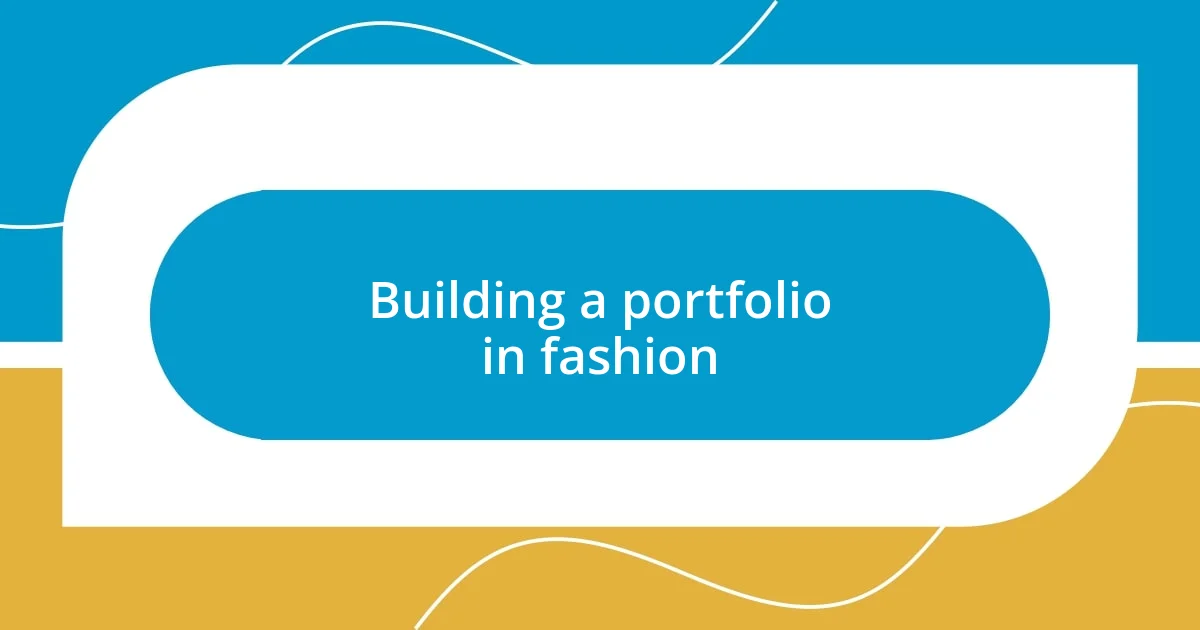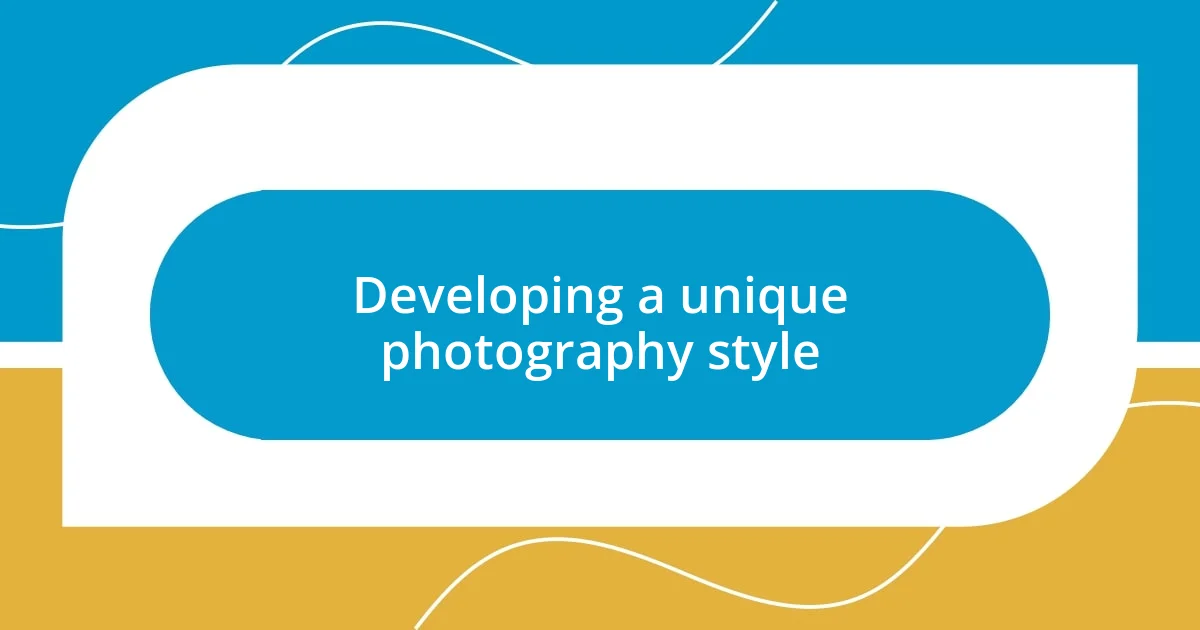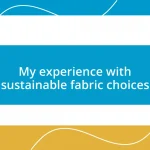Key takeaways:
- Early experiences with photography sparked a lifelong passion, emphasizing how initial moments can shape an artist’s journey.
- Key elements for aspiring fashion photographers include mastering lighting, composition, styling, model direction, and post-processing to create compelling images.
- Networking and building authentic relationships within the fashion industry can open doors to collaborations and opportunities that enhance creative growth.

My early interest in photography
My fascination with photography began when I was just a kid, experimenting with my father’s old film camera. The first images I captured—a backyard bursting with color, my dog caught mid-bark—were such treasures. I can still remember the thrill of not knowing how they would turn out. Isn’t it wonderful how a single moment can ignite a passion?
As I grew older, I found myself drawn to fashion magazines, flipping through pages filled with stunning visuals. I was captivated by how photographers could transform everyday clothing into high art. It made me wonder: how did they convey such deep emotions through just a single shot? Each photo told a story, and I longed to create my own narratives.
I clearly remember my first official photoshoot; it was for a friend’s fashion project. I felt a mix of excitement and nervousness as I clicked the shutter, waiting to see if I’d captured the vibe. That exhilaration solidified my love for fashion photography, fueling a desire to explore this creative outlet further. It’s incredible how these early experiences shaped the artist I am today.

Understanding fashion photography basics
Understanding the essentials of fashion photography is key to bringing your vision to life. It’s not just about pretty clothes; it’s about capturing an emotion or a vibe that resonates with the viewer. I remember attending my first runway show, feeling the buzz in the air and the adrenaline rush as models strutted by. Each click of my camera felt like a heartbeat—capturing that energy was intoxicating.
Here are some basic elements I believe are crucial for any aspiring fashion photographer:
– Lighting: Understanding how different lighting can affect the mood of your shot is fundamental. Natural light differs vastly from studio flash; I often gravitate towards golden hour for its magical quality.
– Composition: The arrangement of elements in your frame can enhance the storytelling aspect. I love experimenting with angles to find the most striking perspectives.
– Styling: Collaborating with stylists to create a cohesive look is essential. The styling choices set the tone for your photos.
– Model Direction: Guiding the model to express the desired emotions helps convey the story you want to tell. I’ve learned that simple cues can make a world of difference.
– Post-Processing: Editing is where you can add your unique touch. For my early shoots, I’d spend hours fine-tuning colors to match my artistic vision.
Each of these elements plays a vital role in crafting a compelling fashion photograph. Embracing them not only enhances your work but also shapes your individual style as a photographer.

Essential gear for fashion photography
When I first ventured into fashion photography, I quickly realized how vital the right gear is to capture striking images. A quality camera is, of course, the backbone. I prefer DSLRs or mirrorless models for their versatility. My journey began with a trusty entry-level DSLR that allowed me to experiment without the overwhelming features of high-end models. I’ve learned that the lens can make or break a photograph, so investing in a good prime lens, like a 50mm, unlocked a whole new world of crisp detail and beautiful bokeh in my images.
In addition to the camera and lens, lighting equipment transformed my shoots. Initially, I relied solely on natural light, which can produce stunning results, but I soon discovered the magic of softboxes and reflectors. I remember a shoot where the sunset was behind us, creating that perfect golden hour glow. Using reflectors, I bounced light onto the model’s face, adding depth and vibrancy that made post-processing a breeze. The combination of quality lighting and thoughtful control can elevate your photography to a professional level.
Here’s a snapshot of the essential gear I believe is indispensable for anyone serious about fashion photography.
| Gear | Purpose |
|---|---|
| Camera (DSLR/Mirrorless) | Captures high-quality images and allows for interchangeable lenses. |
| Prime Lens (e.g., 50mm) | Provides sharp detail and beautiful depth of field. |
| Reflector | Helps bounce light for better illumination of the model. |
| Softbox | Creates soft, diffused light that flatters the subject. |
| Tripod | Stabilizes the camera for long exposures or group shots. |
| Light Meter | Ensures proper exposure settings for various lighting conditions. |

Building a portfolio in fashion
Building a portfolio in fashion is not just about showcasing your best images; it’s about telling a story that reflects your unique perspective as a photographer. I remember the excitement of my first photoshoot, where I worked with local designers and models. Those raw, unfiltered moments became foundational pieces in my portfolio; they encapsulated the essence of my early exploration in this vibrant field. Can you recall a time when you captured something unexpected that spoke volumes about your style?
Curating a diverse selection of work is essential. I found that including a mix of editorial styles, street photography, and even personal projects broadened my narrative. Every photo I chose to include became a chapter in my story, revealing my evolution in technique and vision. While it’s tempting to showcase only the flashy, high-concept images, I learned that highlighting the growth and the experimentation was just as impactful. What does your portfolio say about you?
Collaboration is another key element in building a compelling fashion portfolio. I started seeking out stylists, makeup artists, and even fellow photographers to create cohesive concepts. One project that stands out was a collaborative series inspired by the changing seasons; each shot captured a different mood, and those images still resonate with viewers today. This experience taught me that a portfolio isn’t just a collection of images; it’s a dialogue between multiple artistic voices, each contributing to the overall vision. Have you thought about the importance of collaboration in your own work?

Networking in the fashion industry
Networking in the fashion industry is truly a game changer, as I learned from the beginning of my journey. I remember attending my first fashion event, feeling a mix of excitement and anxiety. Connecting with fellow photographers, models, and designers opened doors to collaborations that shaped my path. Have you ever experienced the thrill of an unexpected conversation leading to a new opportunity?
Building genuine relationships is essential. I found that following up after events, whether through a simple email or social media message, helped solidify those connections. One time, I reached out to a stylist I admired, and we ended up collaborating on a project that received great feedback. This taught me that authentic networking isn’t just about collecting business cards; it’s about nurturing relationships that foster creativity and growth.
It’s important to leverage platforms like Instagram or networking sites specifically for creatives. Sharing your work and engaging with others not only showcases your style but also invites dialogue within the community. I recall a moment when a simple comment on another photographer’s post led to a conversation that ultimately evolved into a photoshoot together. Have you thought about how social media can bridge gaps in the fashion world? For me, it’s been an invaluable tool in building connections that matter.

Developing a unique photography style
Developing a unique photography style is a journey deeply rooted in self-discovery. I remember when I first picked up my camera; I was drawn to vibrant colors and dramatic lighting. It was exhilarating to play with these elements. Yet, over time, I realized that my voice was found in a softer, more melancholic aesthetic. Have you ever taken a step back to reassess what truly resonates with you?
Finding inspiration in different sources can help refine your style. I often find myself revisiting classic films or flipping through old magazines. One particular photoshoot inspired by a vintage Parisian theme transformed my approach entirely. It taught me that influences come from unexpected places, urging me to step away from cliches and embrace what feels authentically mine. What have you discovered about your creative inspirations?
Experimentation is key. I remember a phase where I shot in harsh sunlight, challenging myself to capture the beauty in shadows and contrasts. Those sessions were met with frustration, but they ultimately led to breakthroughs in my style. By pushing boundaries and allowing mistakes to shape my artistic journey, I found a rhythm that felt uniquely my own. Isn’t it fascinating how our struggles often lead us to our best work?

Challenges in fashion photography
One major challenge in fashion photography is the pressure to constantly produce fresh and visually striking content. There was a time when I felt overwhelmed, trying to keep up with fleeting trends and the demand for social media-ready images. It’s like a never-ending race; have you ever found yourself caught in a cycle where creativity seems to dry up? I certainly have, and I learned that taking breaks can sometimes reignite inspiration.
Another hurdle is working with people who may not always share the same vision. I remember a specific shoot where the stylist and I had different ideas about the mood of the photos. It led to misunderstandings and tension on set, and I realized the importance of clear communication. How do you navigate creative differences? For me, discussing visions upfront and being open to compromise was essential in creating a harmonious working environment.
Lastly, dealing with the technical aspects of equipment can be daunting. I’ll never forget the day my camera malfunctioned just as a pivotal shoot was about to begin. My heart raced, and I thought, “What if I lose this opportunity?” Thankfully, I had a backup plan, but it taught me to always prepare for the unexpected. Have you ever faced a technology fail? It’s a reminder that resilience is crucial in fashion photography, as the show must go on, with or without the ideal tools.














